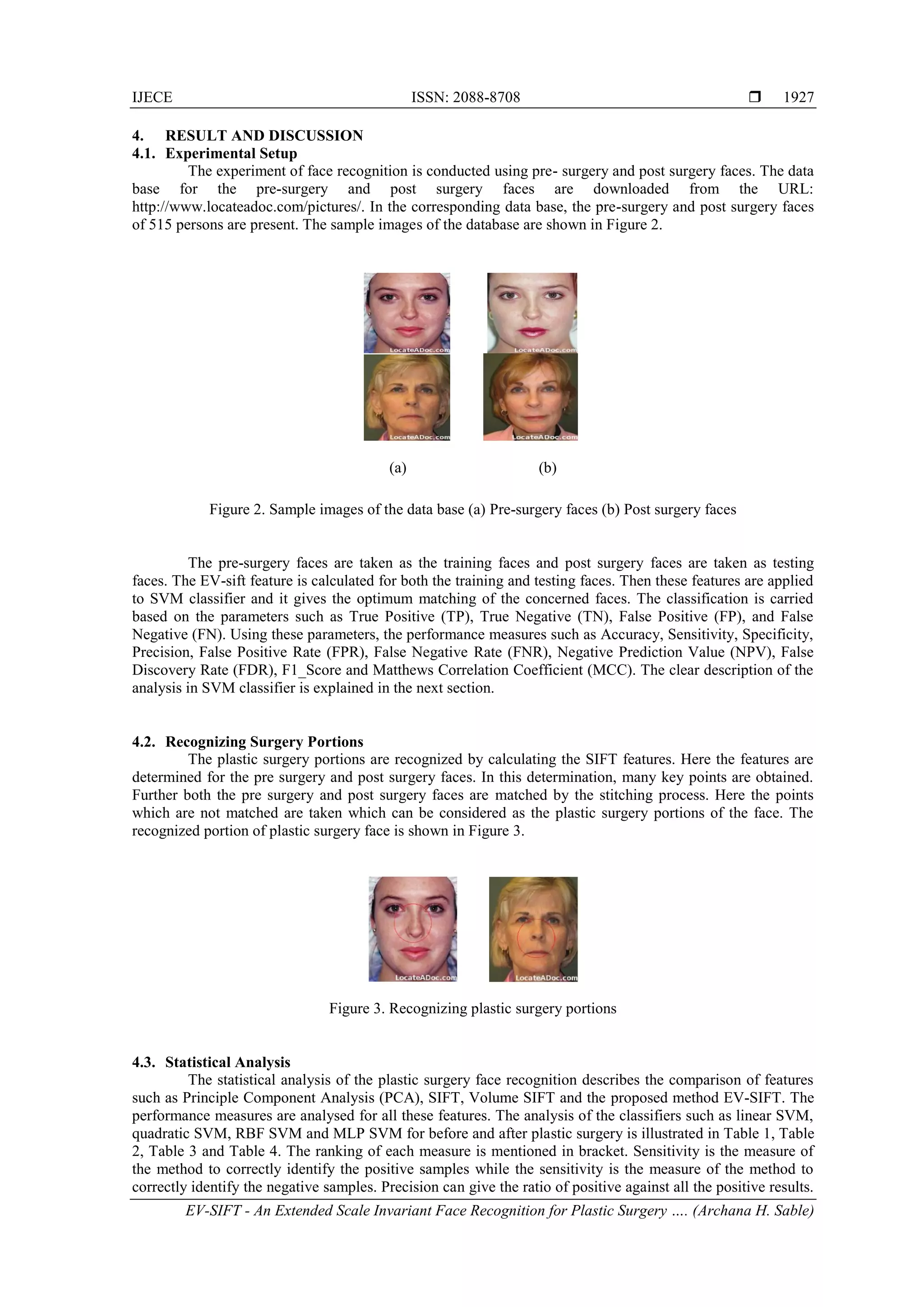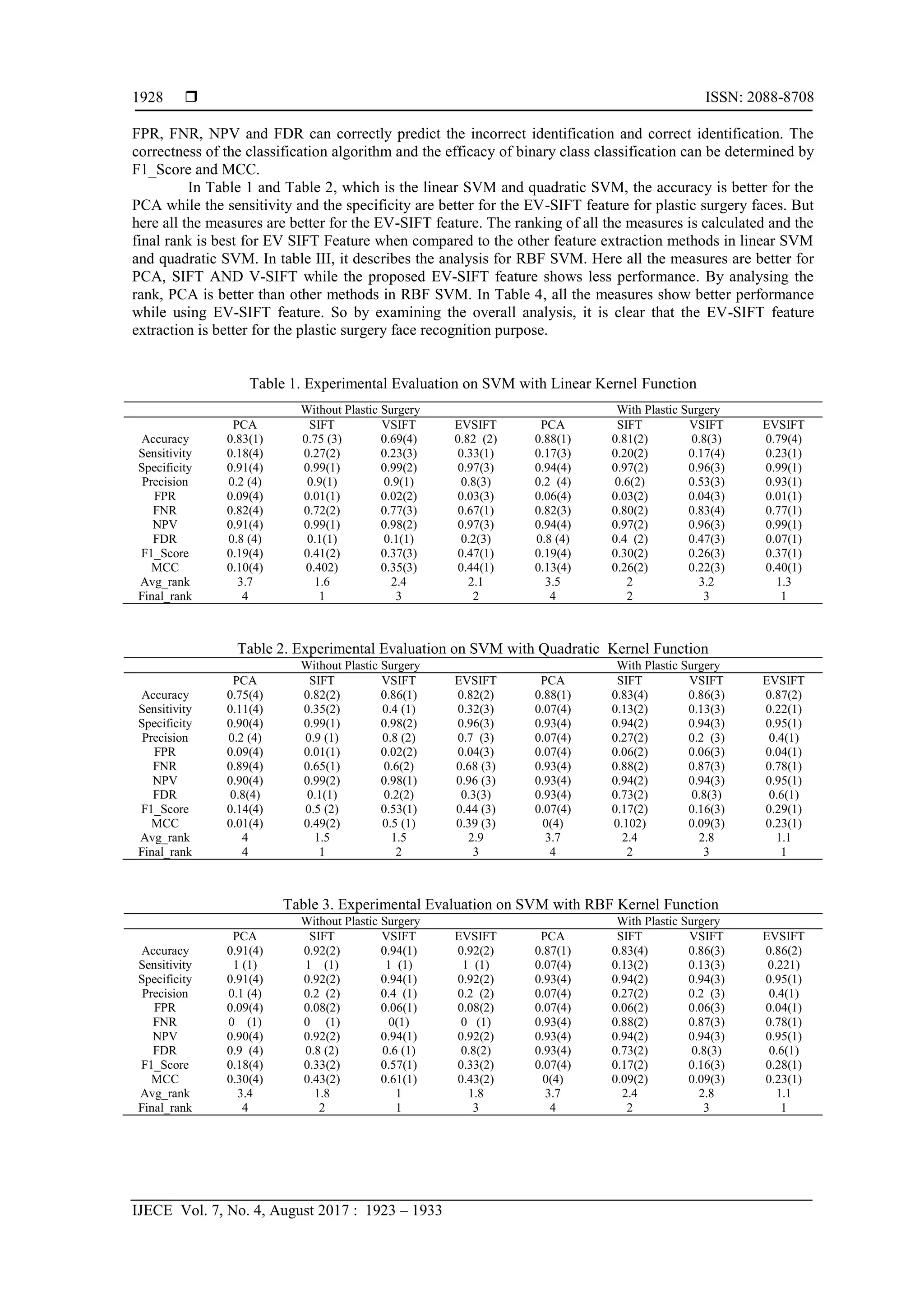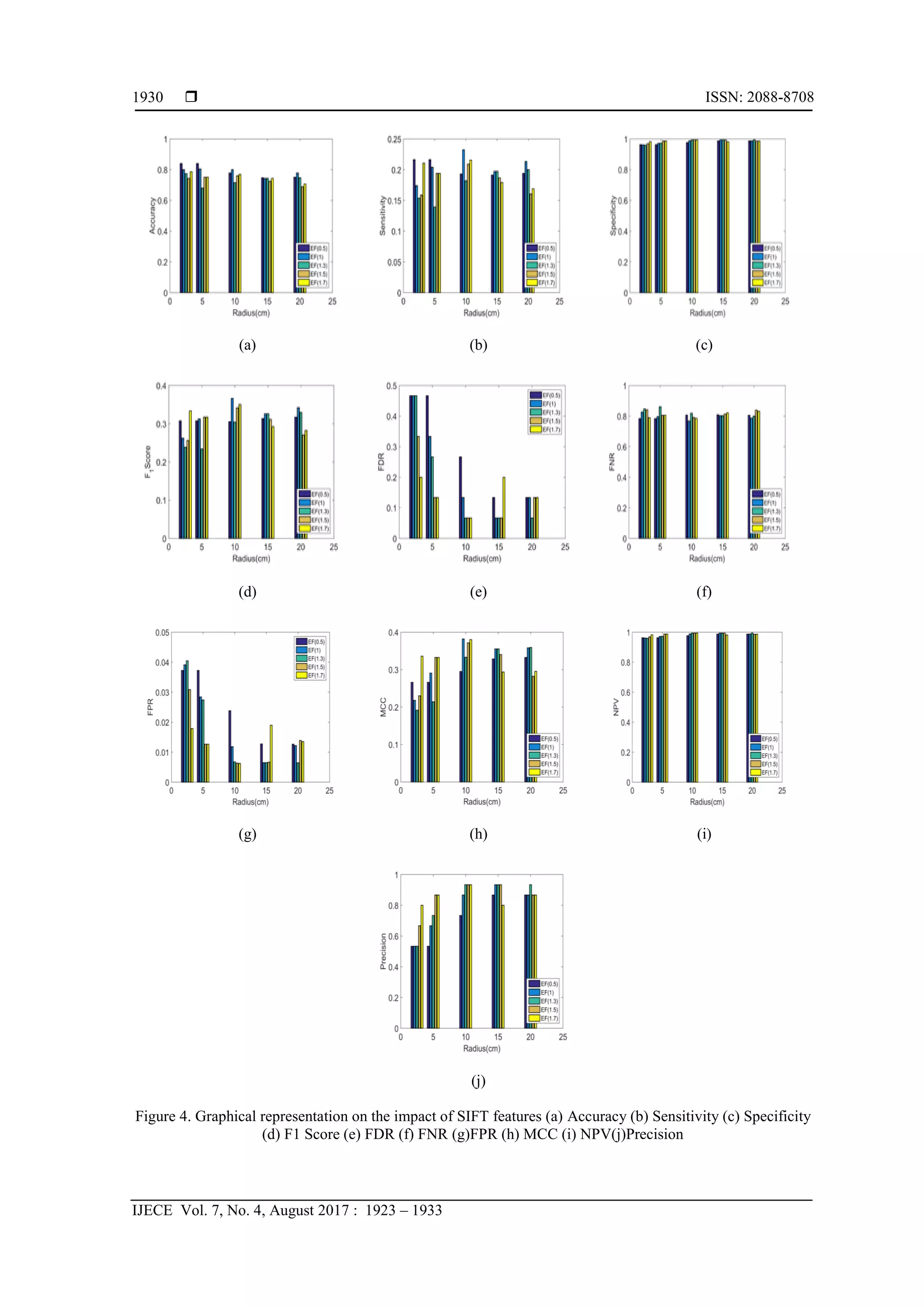This paper introduces the EV-SIFT technique, an advanced face recognition method designed for faces altered by plastic surgery, which extracts key features based on both contrast and volume for improved accuracy. The method integrates support vector machine (SVM) classification and demonstrates superior performance compared to traditional approaches such as PCA and standard SIFT. The study further evaluates the recognition of surgical modifications using a dataset of pre- and post-surgery images, highlighting the challenges and improvements in accuracy achieved with the new technique.
![International Journal of Electrical and Computer Engineering (IJECE)
Vol. 7, No. 4, August 2017, pp. 1923~1933
ISSN: 2088-8708, DOI: 10.11591/ijece.v7i4.pp1923-1933 1923
Journal homepage: http://iaesjournal.com/online/index.php/IJECE
EV-SIFT - An Extended Scale Invariant Face Recognition for
Plastic Surgery Face Recognition
Archana H. Sable1
, Sanjay N. Talbar2
, Haricharan Amarsing Dhirbasi3
1
School of Computational Sciences, S.R.T.M.University, Nanded- 431606, India
2
Department of Electronics and Telecommunication Engg., S.G.G.S.I.E &T., Nanded(M.S), India
3
N.E.S, Science College, S.R.T.M.University Nanded (M.S), India
Article Info ABSTRACT
Article history:
Received Aug 11, 2016
Revised May 15, 2017
Accepted May 30, 2017
This paper presents a new technique called Entropy based SIFT (EV-SIFT)
for accurate face recognition after the plastic surgery. The corresponding
feature extracts the key points and volume of the scale-space structure for
which the information rate is determined. This provides least effect on
uncertain variations in the face since the entropy is the higher order statistical
feature. The corresponding EV-SIFT features are applied to the Support
vector machine for classification. The normal SIFT feature extracts the key
points based on the contrast of the image and the V- SIFT feature extracts the
key points based on the volume of the structure. However, the EV- SIFT
method provides both the contrast and volume information. Thus EV-SIFT
provide better performance when compared with PCA, normal SIFT and V-
SIFT based feature extraction.
Keyword:
EV-SIFT feature
Face recognition
Plastic surgery
SVM classification
Copyright © 2017 Institute of Advanced Engineering and Science.
All rights reserved.
Corresponding Author:
Archana H. Sable,
School of Computational Sciences,
S.R.T.M.University,
Nanded- 431606, India.
Email: helloarchu27@gmail.com
1. INTRODUCTION
Human faces are multi-dimensional and complex visual stimuli, which carry abundant useful
information regarding the uniqueness of a person. Face recognizing utilizing them for security and
authentication purposes has taken a new turn in current era of image analysis and computer vision, for
instance, in applications that include surveillance, image retrieval, human-computer interaction and biometric
authentication. Normally, face recognition system does not need the sense of touch or interaction from
human to conduct the process of recognition. It is one of the advantages of face recognition over the other
recognition methods. Face recognition can denote either in verification phase [1] or the identification phase
[2]. In the verification phase, matching between two faces is resolved. There are lot of methods available to
attain face recognition [3-8]. But the accuracy of recognition is not always high. This is because of the
changing degrees of illumination, facial expressions, poses, aging, low resolution input image or facial marks
[9], [10]. Various researchers have implemented different methodologies of face recognition to tackle the
effect of pose [11], illumination [12], low resolution [13], aging [14] or a combination of any of them [15].
However these uncertainties could be fairly overcome and in the plastic surgery faces, the recognition gets
even more intensified with the identification of person. The failure of recognition in plastic surgery faces is
due to the lack or the variation in face components, skin texture, global face appearance and the geometric
relationship existing among the facial features lack or the variation in face components [16-18]. The cost-
efficient as well as the advanced means of plastic surgery has attracted people all around the globe. However,
only few research contributions or methodologies have been reported in the literature to address the problem
of recognizing the plastic surgery faces. Few of them include, the recognition using local region analysis](https://image.slidesharecdn.com/v2930may1711aug1612150shreefinal-201019061748/75/EV-SIFT-An-Extended-Scale-Invariant-Face-Recognition-for-Plastic-Surgery-Face-Recognition-1-2048.jpg)
![ ISSN: 2088-8708
IJECE Vol. 7, No. 4, August 2017 : 1923 – 1933
1924
[19], Shape Local Binary Texture Feature (SLBT) cascaded with periocular features [20]. A review has also
been done in [21] to illustrate the use of multimodal features in recognizing the plastic surgery based on the
contributions. The contribution of the paper mainly considers three set of demonstrations. The first one is
detection of exact plastic surgery face using the novel SIFT feature based on entropy. The second one is to
accurately recognizing the true surgery portions while the third one is to analyze the performance of face
recognition before and after plastic surgery.
2. LITERATURE REVIEW
2.1. Related Works
Maria De Marsico et al. [22] have made an accurate recognition of face, which has undergone
plastic surgery, through the application of the region-based approaches on a multimodal supervised
collaborative architecture, termed as, Split Face Architecture (SFA). They have validated the superiority of
their methodology through applying the Supervised SFA to traditional PCA and FDA, to LBP in the
Multiscale, Rotation Invariant version with Uniform Patterns, FARO (Face Recognition against Occlusions
and Expression Variations) and FACE (Face Analysis for Commercial Entities).
Naman Kohli et al. [23] have put forth Multiple Projective Dictionary Learning framework (MPDL)
that never desires to compute the and norms to recognize normal faces, even after they have been modified
due to plastic surgery. Multiple projective dictionaries as well as the compact binary face descriptors have
been utilized to learn the local and the global plastic surgery face representations, in order to facilitate the
discrimination of the plastic surgery faces from the original ones. The testing that was done on the plastic
surgery database has resulted in an accuracy of about 97.96%.
Chollette C Chude-Olisah et al. [24] have overcome the degradation in the performance of face
recognition, they have found that their approach has outshined the previously available plastic surgery face
recognition approaches, irrespective of the changes in illumination as well as expressions and the facial
modifications resulting from plastic surgery. Hamid Ouanan [25] have introduced GaborHOG features based
face recognition scheme, which uses HOG instead of DOG in the SIFT. M. I. Ouloul [26] introduced an
efficient face recognition using SIFT descriptor in RGBD images which is based on RGB-D images
produced by Kinect, this type of cameras cost less and it can be used in any environment and under any
circumstances. Himanshu S. Bhatt et al. [27] have introduced a multi-objective evolutionary granular
algorithm, which supports in the matching of images that were taken prior and later to plastic surgery.
Initially, this algorithm does the generation of overlapping face granules at three-levels of granularity. Plastic
surgery face recognitionhave undergone various developments in the recent past. The research contributions
have been reported in the literature either in the feature extraction phaseor in the classification phase or in
both the phases.
3. FEATURE EXTRACTION USING EV-SIFT
Let D
iI be the data base with DNi .......2,1 and jF be the face image which should satisfy the
condition D
ij IF where SNj .....2,1 . The pre-processing stage starts with image resizing. Let the size of the
database D
iI be )( NM . The resize model of image is represented in Equation (1) where MS and MS
represents the scaled number of rows and columns.
Mr
Mr
Nr
Nr
Sm
Smu
Sn
Snv
i
NM
rri vuI
SS
nmIyxI
)1( )1(
),(
1
),(),( (1)
In Equation (1), ],1[ Mu and ],1[ Nv , 10 rr Mm and 10 rr Nn , the term
represents the round-off function of the nearest integer, )( rr NM is the size of the resized image. The
image - scale representation of two dimensional image is determined as given in Equation (1), where
),,( yxG is the variable-scale Gaussian function, ),( yx is the spatial coordinate and is the scale
coordinate.
),(*),,(),,( yxIyxGyxL (2)
Here each sample point of the image compared with 26 neighbours in the DOG scale space in order to find
all the extreme points and 2D image space. The target point is needed to compare with 8 neighbours in the
current image and also with 18 neighbours in the scale above and below. The true scale in variance can be](https://image.slidesharecdn.com/v2930may1711aug1612150shreefinal-201019061748/75/EV-SIFT-An-Extended-Scale-Invariant-Face-Recognition-for-Plastic-Surgery-Face-Recognition-2-2048.jpg)
![IJECE ISSN: 2088-8708
EV-SIFT - An Extended Scale Invariant Face Recognition for Plastic Surgery …. (Archana H. Sable)
1925
estimated from the normalization of Laplacian, G22
with the factor 2
. After convolution with the
normalized Laplacian function, the automatic scale selection can be performed as follows,
),,(),(*),,( 222222
yxLyxIGyxO (3)
The output which is calculated from the convolution of image with ),,( 2
yxO in Equation (3) will
be at extremum if the scale of the image structure is close to the value of the normalized Laplacian
function. The points that are extrema in both spatial and scale spaces should be selected in case of detecting
the blob structure and selecting them at most optimum scale. The next point is to determine the key points at
the scale space extreme in the difference of Gaussian function expressed with the image. It follows some
steps such as,
a. Allocate the Orientation and Gradient Modules to each Key Point
The parameters of the key point are completely depends on the distribution property of the gradient
orientation of the image which is around the key points. So the orientation and gradient modules of the key
point are calculated which registers invariance to image rotation. The gradient magnitude and orientation is
calculated for each image sample.
b. Volume based Feature Descriptor
V-SIFT feature is same as SIFT where it uses the volume of the structure instead of taking the
contrast as in normal SIFT feature. In the normal SIFT feature, the image scale space extreme is detected in
the first step. From that it is known that the Laplacian is a second-order derivative which is very sensitive to
noise. V-SIFT[28][29] are implemented to overcome this limitation and also it can completely remove the
unreliable key points.In this technique here is some unique maximum over scales in,
222
1
2
2222
)(
,0,0(),0,0(
LO (4)
In this method the value of ),,( 2
yxO in Equation (4) should be calculated at each key point
location and if the value is below the threshold, the corresponding key points are removed. In the normal shift
algorithm, the key points are removed based on the contrast value at the location of the key point of the
image. But in V-SIFT, it is based on the volume of the structure which is estimated as follows,
),(*),,(),,( 24222
yxIGyxOyxV (5)
In Equation (5), is the scale of the corresponding key point. We can derive the above equation as,
),,((),,( 2
11
2
1
2
11 yxOyxV (6)
),,((),,( 2
22
2
2
2
22 yxOyxV (7)
From Equation (6) and (7), the extrema value of
2
11 ,,( yxO ) and ),,(
2
21 yxO is same but the
extrema of ),,(
2
11 yxV and ),,(
2
22 yxV are different. There is a rule in this case which is in Equation (14).
extremaextrema yxVyxV ),,(),,(
2
22
2
11 (8)
In V-SIFT approach all cases, first we should evaluate the value of ),,( 2
yxV at each candidate key
point location and remove if it is below some threshold value.
c. Entropy based Feature Descriptor
Entropy is the measure of unpredictability of the content of the information in an image. It is the
statistical measure of randomness which can be used to characterize the texture of the input image. Since the
entropy is the higher order statistical feature it can have least effect on uncertain variations in the face.
Entropy based feature descriptor is demonstrated in following steps.
Step1: The volume of the image is calculated as in V-SIFT formulation and it will be in the form of
matrix which is determined in Equation (9).](https://image.slidesharecdn.com/v2930may1711aug1612150shreefinal-201019061748/75/EV-SIFT-An-Extended-Scale-Invariant-Face-Recognition-for-Plastic-Surgery-Face-Recognition-3-2048.jpg)





![IJECE ISSN: 2088-8708
EV-SIFT - An Extended Scale Invariant Face Recognition for Plastic Surgery …. (Archana H. Sable)
1931
4.5. Sensitivity to Plastic Surgery Faces
The graphical representation of the ranking of different kernel of SVM classifier like linear,
quadratic, RBF and MLP for with and without plastic surgery is shown in Figure 5. Generally, pre- surgery
and post-surgery faces may have high variation in their features. In Figure 5, the rank of pre-surgery face is
high where as the rank of post surgery face is low. Therefore, it is clear that the proposed EV-SIFT feature is
highly sensitive to plastic surgery faces.
(a) (b)
Figure 5. Ranking of different SVM kernel using PCA, SIFT, V-SIFT and EV-SIFT (a) Without plastic
surgery (b) With plastic surgery
5. CONCLUSION
This paper has presented a face recognition technique that uses derived features based on EV-SIFT
approach. The corresponding system was evaluated using plastic surgery image database of 515 subjects
where it contains each image of pre-surgery and post surgery faces. The proposed EV-SIFT approach has
obtained the volume of the structure and the contrast of the image and also it has removed all the unwanted
key points effectively. The extracted features were applied to the SVM classifier for the recognition purpose.
The performance measures were analyzed in different kernel of SVM with different existing features. Here
EV-SIFT feature was effective for producing the best performance. The parameters of SVM classifier such
as radius and enlarge factor was varied. From the analysis it was clear that, the performance was better for
varied values of radius and EF and it was not fixed. So here a proper tuning was needed for obtaining the
fixed value. In future work, the analysis based on the tuning process will be done to have the accurate
recognition of plastic surgery face.
ACKNOWLEDGEMENTS
First of all, I thank Lord Shri Gajanan Maharaj for giving me strength and ability to complete this
study. Futhermore, I would express my gratitude to my research guide Prof. S.N. Talbar for their powerful
guidance, motivation, valuable suggestions, support and attention throughout this research. I thank all my
friends for sharing their experiences and knowledge. Special thank to My Husband for providing moral
support and always encouraging me to do good research.
REFERENCES
[1] Anil Kumar Sao, B. Yegnanarayana, “Face Verification using Template Matching”, IEEE Transactions on
Information Forensics and Security, vol. 2, no. 3, pp. 636-641, Sep. 2007.
[2] William Robson Schwartz, Huimin Guo, Jonghyun Choi, Larry S. Davis, “Face Identification using Large Feature
Sets”, IEEE Transactions on Image Processing, vol. 21, no. 4, pp. 2245-2255, April 2012.
[3] M. A. Turk, A. P. Pentland, “Face Recognition using Eigenfaces”, In Proceedings of the IEEE Computer Society
Conference on Computer Vision and Pattern Recognition, Maui, HI, 1991, pp. 586- 591.
[4] J. Ruiz-del-Solar, P. Navarrete, “Eigenspace-based face Recognition: A Comparative Study of different
Approaches”, IEEE Transactions on Systems, Man, and Cybernetics, Part C (Applications and Reviews), vol. 35,
no. 3, pp. 315-325, Aug. 2005.
[5] S. Lawrence, C. L. Giles, Ah Chung Tsoi, A. D. Back, “Face Recognition: A Convolutional Neural-Network
Approach”, IEEE Transactions on Neural Networks, vol. 8, no. 1, pp. 98-113, Jan.1997.
[6] Xiaofei He, Shuicheng Yan, Yuxiao Hu, P. Niyogi, Hong-Jiang Zhang, “Face Recognition using Laplacianfaces”,
IEEE Transactions on Pattern Analysis and Machine Intelligence, vol. 27, no. 3, pp. 328-340, March 2005.
[7] Tolga Inan, Ugur Halici, “3-D Face Recognition With Local Shape Descriptors”, IEEE Transactions on Information
Forensics and Security, vol. 7, no. 2, pp. 577-587, April 2012.](https://image.slidesharecdn.com/v2930may1711aug1612150shreefinal-201019061748/75/EV-SIFT-An-Extended-Scale-Invariant-Face-Recognition-for-Plastic-Surgery-Face-Recognition-9-2048.jpg)
![ ISSN: 2088-8708
IJECE Vol. 7, No. 4, August 2017 : 1923 – 1933
1932
[8] Ze Lu, Xudong Jiang, Alex C. Kot, “A Color Channel Fusion Approach for Face Recognition”, IEEE Signal
Processing Letters, vol. 22, no. 11, pp. 1839-1843, Nov. 2015.
[9] Yong Xu, Xiaozhao Fang, Xuelong Li, Jiang Yang, Jane You, Hong Liu, Shaohua Teng, “Data Uncertainty in Face
Recognition”, IEEE Transactions on Cybernetics, vol. 44, no. 10, pp. 1950-1961, Oct. 2014.
[10] Anil K. Jain, Brendan Klare, Unsang Park, “Face Recognition: Some Challenges in Forensics”, 2011 IEEE
International Conference on Automatic Face & Gesture Recognition and Workshops (FG 2011), Santa Barbara,
2011, pp. 726- 733.
[11] Poonam Sharma, Ram N. Yadav, Karmveer V. Arya, “Pose-Invariant face Recognition using Curvelet Neural
Network”, IET Biometrics, vol. 3, no. 3, pp. 128-138, Sep. 2014.
[12] Sang-Heon Lee, Dong-Ju Kim, Jin-Ho Cho, “Illumination-Robust face Recognition System based on Differential
Components”, IEEE Transactions on Consumer Electronics, vol. 58, no. 3, pp. 963-970, Aug 2012.
[13] Wilman W. W. Zou, Pong C. Yuen, “Very Low Resolution Face Recognition Problem”, IEEE Transactions on
Image Processing, vol. 21, no. 1, pp. 327-340, Jan 2012.
[14] Unsang Park, Yiying Tong, Anil K. Jain, “Age-Invariant Face Recognition”, IEEE Transactions on Pattern Analysis
and Machine Intelligence, vol. 32, no. 5, pp. 947-954, May 2010.
[15] 15. Sivaram Prasad Mudunuri, Soma Biswas, “Low Resolution Face Recognition Across Variations in Pose and
Illumination”, IEEE Transactions on Pattern Analysis and Machine Intelligence, vol. 38, no. 5, pp. 1034-1040, May
2016.
[16] Richa Singh, Mayank Vatsa, Afzel Noore, “Effect of Plastic Surgery on face Recognition: A Preliminary Study”,
2009 IEEE Computer Society Conference on Computer Vision and Pattern Recognition Workshops, Miami, FL,
2009, pp. 72- 77.
[17] Richa Singh, Mayank Vatsa, Himanshu S. Bhatt, Samarth Bharadwaj, Afzel Noore, Shahin S. Nooreyezdan,
“Plastic Surgery: A New Dimension to Face Recognition”, IEEE Transactions on Information Forensics and
Security, vol. 5, no. 3, pp. 441- 448, Sep. 2010.
[18] Xin Liu, Shiguang Shan, Xilin Chen, “Face Recognition after Plastic Surgery: A Comprehensive Study”, Computer
Vision – ACCV 2012, Lecture Notes in Computer Science, Springer, vol. 7725, pp. 565-576.
[19] Maria De Marsico, Michele Nappi, Daniel Riccio, Harry Wechsler, “Robust Face Recognition after Plastic Surgery
Using Local Region Analysis”, Image Analysis and Recognition, Lecture Notes in Computer Science, Springer, vol.
6754, pp. 191-200.
[20] N. S. Lakshmiprabha, S. Majumder, “Face Recognition System Invariant to Plastic Surgery”, 2012 12th
International Conference on Intelligent Systems Design and Applications (ISDA), Kochi, 2012, pp. 258-263.
[21] Abha R. Gulhane, S. A. Ladhake, S. B. Kasturiwala, “A Review on Surgically Altered face Images Recognition
using Multimodal Bio-metric Features”, in Proceedings of the 2015 2nd International Conference on Electronics
and Communication Systems (ICECS), Coimbatore, 2015, pp. 1168-1171.
[22] Maria De Marsico, Michele Nappi, Daniel Riccio, Harry Wechsler, “Robust face Recognition after Plastic Surgery
using Region-based Approaches”, Pattern Recognition, vol. 48, no. 4, pp. 1261-1276, April 2015.
[23] Naman Kohli, Daksha Yadav, Afzel Noore, “Multiple Projective Dictionary Learning to Detect Plastic Surgery for
Face Verification”, IEEE Access, vol. 3, pp. 2572-2580, 2015.
[24] Chollette C. Chude-Olisah, Ghazali B. Sulong, Uche A. K. Chude-Okonkwo, Siti Z. M. Hashim, “Edge-based
Representation and Recognition for Surgically Altered face Images”, in Proceedings of the 2013 7th International
Conference on Signal Processing and Communication Systems (ICSPCS), Carrara, VIC, 2013, pp. 1-7.
[25] Hamid Ouanan, Mohammed Ouanan, “GaborHOG Features based face Recognition Scheme,” TELKOMNIKA
Indonesian Journal of Electrical Engineering, vol. 15, no. 2, 2015, pp. 331-335.
[26] M. I. Ouloul, Z. Moutakki, K. Afdel, A. Amghar, “An Efficient Face Recognition using SIFT Descriptor in RGBD
Images,” International Journal of Electrical and Computer Engineering (IJECE), vol. 5, no. 6, 2015.
[27] Himanshu S. Bhatt, Samarth Bharadwaj, Richa Singh, Mayank Vatsa, “Recognizing Surgically Altered Face Images
Using Multiobjective Evolutionary Algorithm”, IEEE Transactions on Information Forensics and Security, vol. 8,
no. 1, pp. 89-100, Jan. 2013.
[28] Dhyaa Shaheed Sabr Al-Azzawy, “Eigenface and SIFT For Gender Classification”, Wasiit Journall for Sciience &
Medicine, vol. 5, no. 1, pp. 60-76, 2012.
[29] Cong Geng, Xudong Jiang, “Face Recognition using SIFT Features”, 16th IEEE International Conference on Image
Processing (ICIP), pages 3313-3316, 2009.
BIOGRAPHIES OF AUTHORS
Archana H. Sable, she received ME degree in computer Science & engineering from M.G.M’s College of
Engg., SRTM University, Nanded. Her research interests are Image processing, Pattern recognizing and
Computer vision. She is doing Ph.D (Thesis) in Computer Engg from SRTM University, Nanded. Her
email address is helloarchu27@gmail.com.
Sanjay N. Talbar received his B.E and M.E degrees from SGGS Institute of Technology, Nanded, India
in 1985 and 1990 respectively. He obtained his PhD from SRTM University, Nanded, India in 2000. He
received the “Young Scientist Award” by URSI, Italy in 2003. He hadCollaborative research programme
at Cardiff University Wales, UK. Presently he is working as Professor and Head, Department of
Electronics & Telecommunication Engg., SGGS Institute of Engineering &Technology Nanded, India. He
has published 50 journal papers, 10 books and more than 125 papers in referred National as well as
International Conferences. His research interests includes Image processing, Medical Image processing,
Multimedia Computing and Embedded System Design.He is a member of IEEE, IET, IETE, AMPI, ISTE,
and worked on many prestigious committees in academic field of India.](https://image.slidesharecdn.com/v2930may1711aug1612150shreefinal-201019061748/75/EV-SIFT-An-Extended-Scale-Invariant-Face-Recognition-for-Plastic-Surgery-Face-Recognition-10-2048.jpg)
